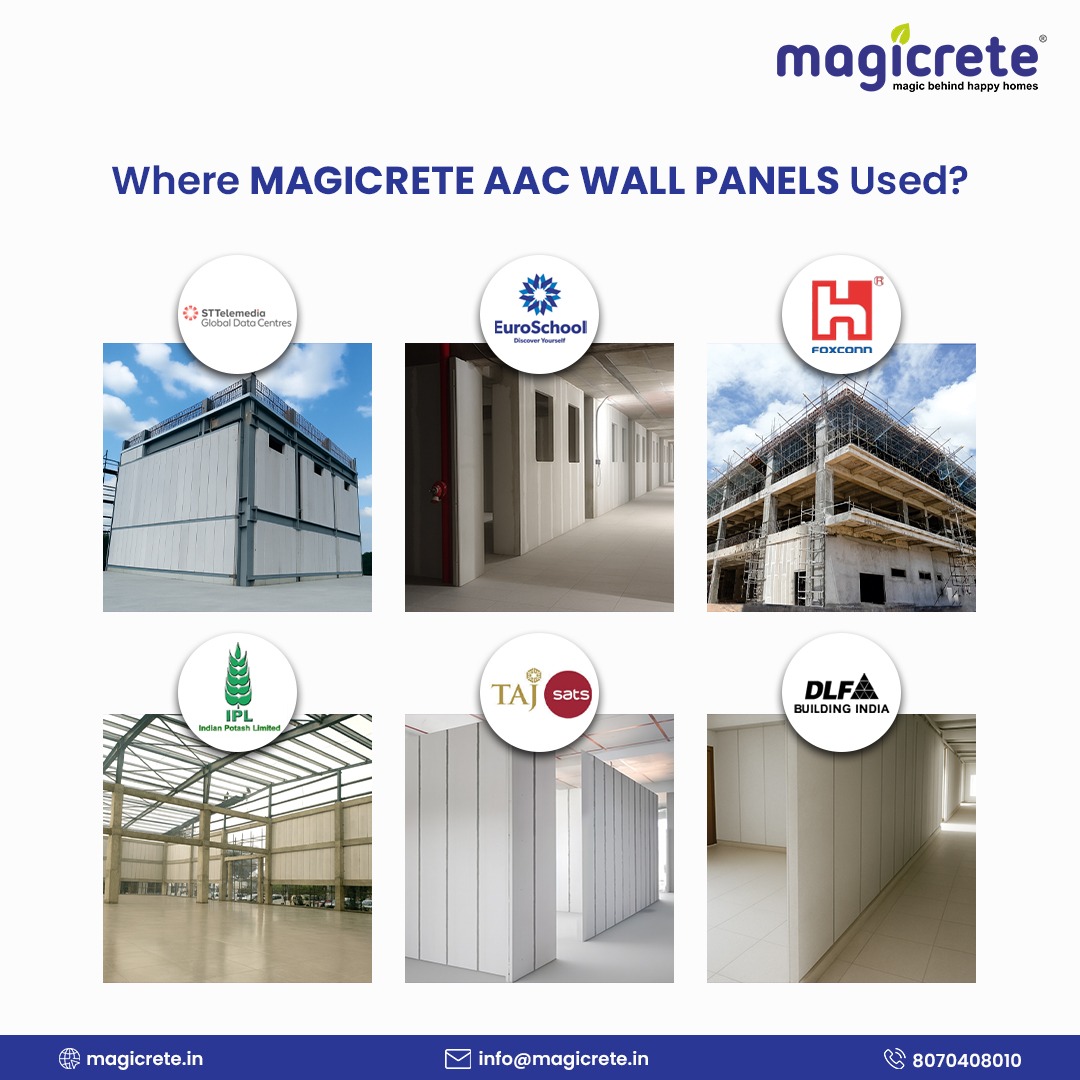Understanding AAC Wall Panel Applications in Modern Construction
As construction timelines shrink and energy efficiency becomes non-negotiable, AAC wall panels are finding their way into every kind of project, from modern villas to hospitals. But where exactly do they fit best? The versatility of AAC wall panel application makes them ideal for both residential and commercial buildings, offering a unique combination of structural integrity, speed of construction, and practical performance. These lightweight, modular panels are redefining wall systems in modern construction.
Common Applications of AAC Panels for Construction
Understanding where and how to use AAC panels is key to leveraging their full benefits in construction. Whether you're building a luxury home or a commercial tower, the adaptability of aerated concrete panels helps reduce timelines, improve insulation, and simplify construction logistics.
Residential Applications of AAC Panels
AAC panels are a game-changer in residential building design, offering performance advantages and faster project execution.
- Interior partition walls in villas, apartments, and bungalows
AAC panels for interior walls reduce noise transfer and speed up installation. Their precision-cut edges ensure a clean, modern finish with minimal plastering.
- AAC panels as drywall replacements
Compared to traditional gypsum drywall, AAC panels offer superior durability, fire resistance, and sound insulation. They are ideal for households looking for performance and longevity.
- Panel use in quick-turnaround renovations
The dry and modular installation system makes AAC panels perfect for fast renovation projects with tight deadlines and limited labor.
AAC Wall for Commercial Building Projects
In commercial environments, AAC panels meet the growing demand for lightweight, sustainable, and cost-effective materials.
- Office partitions, malls, hotel structures
Commercial AAC panels provide flexibility for dynamic workspaces and soundproofing for private areas like hotel rooms or meeting rooms.
- Ideal for HVAC-dense areas
Lightweight AAC panels reduce structural load while supporting energy efficiency in HVAC-heavy zones like shopping malls or tech offices.
- Perfect for high-rises (low dead load)
Autoclaved aerated concrete panels significantly reduce dead load, making them ideal for tall buildings where weight savings contribute to overall structural economy.
Institutional & Industrial Use
AAC panels perform exceptionally well in regulated environments with strict acoustic, thermal, and safety requirements.
- Hospitals, factories, and IT parks
Fire-rated AAC panels are certified to meet critical safety norms. Their clean, durable surfaces suit healthcare and industrial use.
- Educational institutes
Educational institutes, clean rooms, and conference spaces benefit from the quiet and fast-install nature of AAC wall panels.
- Dry walls in pharma & clean rooms
The non-dusting, modular nature of AAC panels supports hygienic environments and simplifies compliance in pharmaceutical and electronics manufacturing.
Choosing the Right AAC Panel Thickness for Your Project
Selecting the correct AAC (Autoclaved Aerated Concrete) panel thickness is essential to ensure both structural performance and cost-effectiveness. Panel thickness depends on the type of project, load-bearing requirements, insulation needs, and speed of construction.
- 75–100 mm Panels – Best suited for internal partitions in residential, commercial, and office projects. They save space and offer quick installation.
- 125–150 mm Panels – Ideal for external walls and non-load-bearing applications where higher sound insulation and fire resistance are required.
- 200 mm+ Panels – Recommended for structural walls, industrial buildings, and projects demanding superior strength, durability, and thermal comfort.
By balancing strength, insulation, and space utilization, the right AAC panel thickness ensures faster construction, reduced costs, and long-lasting performance.
Real Projects Where AAC Panels Were Successfully Used

Magicrete AAC Wall Panels have played a transformative role in projects across India, proving their value in both speed and sustainability. Below are some key highlights that demonstrate the wide-ranging applications and performance benefits of Magicrete AAC panels:
- Warehouse – Uttar Pradesh
The project involved using 100 mm Magicrete AAC wall panels for the external walls of a 50,000 sq.ft. warehouse. The entire project wih 4m high wall was installed in just 10 days by a team of 12 laborers, demonstrating significant time savings compared to traditional brickwork.
- Low Cost Housing – Pune
Magicrete AAC wall panels enabled over 1,000 sq ft of installation per day with only 10 laborers, significantly accelerating the project timeline. By opting for the more efficient 100 mm panels over the minimum 150 mm thick blocks, the client achieved dual benefits of material cost savings and increased carpet area efficiency. Furthermore, the panels streamlined the finishing process, allowing for direct application of Gypsum punning without the need for traditional internal plastering.
- Hospital – Mumbai
Fire-rated AAC wall panels replaced PUF panels, met strict healthcare safety standards, enabling rapid and durable construction in a high-compliance environment.
- IT Park – Hyderabad
AAC panels are used to create sound-insulated and reconfigurable office spaces. Their modularity allowed for layout adjustments without disrupting ongoing operations.
- High-Rise Residential Tower – Delhi
Magicrete panels helped reduce overall dead load, improving floor plan efficiency and reducing crane cycles during construction.
- Data Center – Pune
n this project, 150mm Magicrete AAC Wall Panels replaced 200mm solid concrete blocks. This strategic switch accelerated timelines, significantly reduced the overall dead load, and supported client occupancy of the entire facility. Magicrete is now the trusted partner, delivering fast, flexible, and sustainable walling solutions for their upcoming Data Center.
- Bullet Train Project – Multiple Cities
Magicrete panels were chosen for critical infrastructure components due to their precision, high strength, and compliance with strict project timelines.
- Metro Stations & Airports – Multiple Cities
Trusted for their acoustic insulation and lightweight nature, AAC panels were used in terminals and underground stations to meet modern transportation needs.
- Educational Institutions – Bangalore
AAC panels enabled faster construction of classrooms and facilities, with superior soundproofing and fire safety, ideal for a study environment.
These case studies demonstrate that Magicrete AAC panels are more than just efficient, they're trusted by India’s top developers and infrastructure leaders for delivering reliable, modern building solutions.
Conclusion
AAC wall panels are transforming construction with their speed, performance, and sustainability. Whether you're designing a smart home, a high-rise office, or an industrial clean room, AAC panel applications deliver long-term value.
By selecting the right type and thickness, and understanding their best-use cases, you can maximize efficiency, safety, and comfort in your projects.
Need expert advice on your AAC wall panel application? Connect with the Magicrete team.
FAQs
Where can I use AAC wall panels?
→ AAC panels are suitable for internal walls, dry walls, partitioning, and even some structural roles in low-rise buildings.
Can AAC panels be used for exterior walls?
→ Yes, AAC wall panels are perfect for external cladding and façades.
Are AAC wall panels good for soundproofing?
→ Definitely. The cellular structure of AAC provides excellent acoustic insulation of up to 43 dB — great for homes, hotels, and offices.
Do AAC wall panels need plastering?
→ Minimal. A thin finishing coat is usually enough, saving time and cost on labor and materials.
How long does AAC panel installation take?
→ A skilled crew can install up to 150 sqm/day. The dry installation process speeds up project timelines significantly.
What are the environmental benefits of AAC panels?
→ This GRIHA and IGBC recognised product is energy-efficient and low-waste, helping to reduce carbon footprint during construction and operation.



